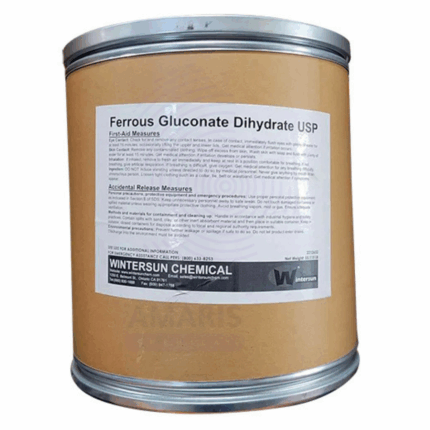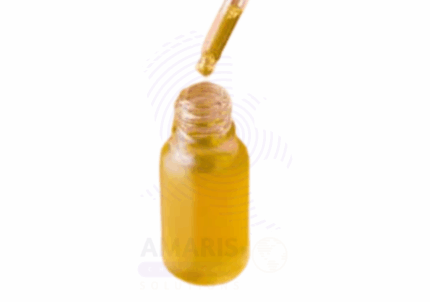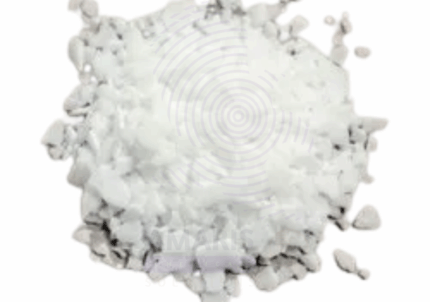
Glycerol Monostearate
$ 2.79 Original price was: $ 2.79.$ 2.67Current price is: $ 2.67.
Glycerol Monostearate Flakes
Whatsapp Order
Glycerol Monostearate Flakes is a white to off-white waxy flake form emulsifier composed of 40% monoglycerides of fatty acids, primarily stearic and palmitic acids, combined with other glycerides and esters. Derived mainly from vegetable oils, this food-grade emulsifier is widely utilized in food, cosmetic, pharmaceutical, and industrial sectors for its multifunctional properties. GMS 40% flakes serve as effective emulsifiers, stabilizers, anti-caking agents, and texture enhancers, with excellent compatibility and versatility in formulations requiring semi-solid or solid fats.
Description
Table of Contents
Toggle
Glycerol Monostearate Flakes
Primary Uses
- Food Industry
- Emulsifying agent in margarine, spreads, and shortenings to blend fats and water, improving texture and consistency.
- Acts as an anti-caking and anti-staling agent in baked goods, improving softness and extending shelf life.
- Used in ice cream and dairy products to enhance creaminess, smoothness, and melt properties.
- Functions as a stabilizer in confectionery for uniformity and improved mouthfeel.
- Utilized in chocolate and coatings to improve gloss and texture by controlling fat crystallization.
- Serves as a release agent in baking and candy manufacturing, preventing product sticking.
- Added to instant mixes and beverages to stabilize oil-water emulsions and maintain shelf stability.
- Pharmaceuticals & Nutraceuticals
- Employed as an excipient in topical creams, ointments, and gels for enhanced emulsification and texture.
- Functions as a tablet binder and dispersing agent in solid dosage forms.
- Used in nutritional supplements to aid in the uniform distribution of fat-soluble vitamins and oils.
- Cosmetics & Personal Care
- Emulsifier and thickener in creams, lotions, body butters, and hair conditioners.
- Improves skin feel and spreadability, providing a smooth and non-greasy texture.
- Acts as a stabilizer and opacifier in shampoos, liquid soaps, and sunscreen formulations.
- Enhances the water resistance and longevity of makeup and sunscreen products.
- Industrial Applications
- Used as an antistatic and lubricating agent in plastics, rubber, and packaging films.
- Functions as a processing aid and internal lubricant in polymer extrusion.
- Serves as a softening agent in textile processing and finishing.
Secondary Uses
- Agriculture
- Functions as an emulsifier in pesticide formulations to improve dispersion and efficacy.
- Used in animal feed supplements for improved mixing and stability.
- Personal Hygiene Products
- Added in deodorants, shaving creams, and cleansing bars for enhanced texture and stability.
- Paints & Coatings
- Used as a dispersing and emulsifying agent to improve consistency and finish.
KEY PRODUCT FEATURES
1. Basic Identification Attributes
- Chemical Name (IUPAC): 1-Monostearoyl-rac-glycerol
- Common/Trade Name: Glycerol Monostearate (GMS)
- CAS Number: 31566-31-1 (commercial blends)
- HS Code: 2915.90.70
- Molecular Formula: C21H42O4 (pure monostearate)
- Molecular Weight: ~358.56 g/mol
- Synonyms:
- Glyceryl monostearate
- GMS 40
- Monostearin
- E471 (food additive)
- Octadecanoic acid monoglyceride
2. Physical & Chemical Properties
- Physical State: Waxy flakes
- Color & Odor: White to off-white; faint fatty odor
- Purity: Approx. 40% monoglycerides content
- Melting Point: 55–65 °C
- Solubility:
- Insoluble in water
- Soluble in hot ethanol, oils, and fats
- pH (1% dispersion): 6–8
- HLB Value: 3.8–5.6 (oil-in-water emulsifier)
3. Safety & Hazard Attributes
- GHS Classification: Not hazardous
- NFPA Ratings: Health 0, Flammability 1, Reactivity 0
- Toxicity: Non-toxic and Generally Recognized As Safe (GRAS)
- Irritation: Mild skin or eye irritant at high concentrations
4. Storage & Handling Attributes
- Container Type: Multi-wall paper bags with polyethylene liner or fiber drums
- Storage Conditions: Store in a cool, dry, ventilated area, away from moisture and heat
- Shelf Life: Up to 24 months under recommended conditions
- Handling Notes: Avoid dust formation; keep container tightly closed
5. Regulatory & Compliance Attributes
- Food Grade: Complies with FDA GRAS, EU E471, JECFA standards
- Pharmaceutical Grade: USP/NF grades available
- REACH Registered: Yes
- Halal and Kosher: Certificates available depending on supplier
6. Environmental & Health Impact
- Biodegradability: Easily biodegradable
- Ecotoxicity: Low environmental toxicity
- Bioaccumulation: Not expected
- Carcinogenicity/Mutagenicity: No evidence of carcinogenic or mutagenic effects
SAFETY HANDLING PRECAUTIONS
Safety Handling Precautions
- PPE Required: Gloves, dust mask, safety goggles
- Handling Guidelines: Avoid inhalation of dust, avoid skin and eye contact
- Hygiene: Wash hands after handling; avoid eating or drinking during handling
First Aid Measures
- Inhalation: Move to fresh air; consult a physician if symptoms persist
- Skin Contact: Wash with soap and water
- Eye Contact: Rinse thoroughly with water for 15 minutes; seek medical advice if irritation persists
- Ingestion: Rinse mouth; seek medical attention if large quantities ingested
Firefighting Measures
- Fire Hazards: Combustible solid at high temperature
- Extinguishing Media: Water spray, foam, dry chemical, CO₂
- Combustion Products: Carbon oxides and fatty acid fumes
- Firefighter PPE: Use self-contained breathing apparatus and protective clothing
Related products
Ferrous Gluconate
Ferrous Gluconate is an iron salt of gluconic acid, appearing as a pale greenish-blue or green crystalline powder or granules. It is widely used as a nutritional iron supplement and food additive due to its good bioavailability and relatively low toxicity compared to other iron salts. Ferrous Gluconate is water-soluble, providing a stable source of ferrous iron (Fe²⁺) that is easily absorbed in the gastrointestinal tract. This compound is commonly employed in pharmaceuticals, food fortification, and medical formulations to treat or prevent iron deficiency anemia. It is also used as a reducing agent and color stabilizer in various industrial applications.
Magnesium Chloride
Magnesium Chloride is a white crystalline salt or granular solid composed of magnesium and chloride ions, commonly found as the hexahydrate form (MgCl₂·6H₂O). It is highly soluble in water, forming a clear, colorless solution with a slightly bitter saline taste. Magnesium Chloride is valued for its hygroscopic properties and is widely used across multiple industries including de-icing, chemical manufacturing, agriculture, food, pharmaceutical, and textile applications. It acts as a source of magnesium, a vital mineral for various biological and industrial processes.
Magnesium Oxide
Magnesium Oxide (MgO) is a white, odorless, alkaline earth metal oxide powder. It is produced by calcining magnesium carbonate or hydroxide at high temperatures, resulting in a fine, white powder with a high melting point. Magnesium Oxide is widely used for its refractory properties, chemical stability, and ability to neutralize acids. It serves important roles in pharmaceuticals, agriculture, environmental applications, and various industrial processes.
Maltitol Powder
Maltitol Powder is a white, crystalline polyol (sugar alcohol) derived from hydrogenated maltose obtained from starch sources like corn or wheat. It is a low-calorie, high-sweetness sugar substitute with about 90% the sweetness of sucrose but significantly fewer calories (approximately 2.1 kcal/g vs. 4 kcal/g for sugar). It has excellent solubility, low hygroscopicity, and provides a clean, sweet taste without an aftertaste. Maltitol Powder is widely used in food, pharmaceutical, and nutraceutical applications for its sugar-like properties, making it suitable for diabetic, low-carb, and dental-friendly formulations.
Polyglycerol-10-Laurate
Polyglycerol-10-Laurate is a non-ionic, biodegradable surfactant and emulsifier derived from natural lauric acid and polyglycerol (with ten glycerol units). It is known for its excellent emulsifying, dispersing, and solubilizing properties, especially in oil-in-water systems. Commonly used in cosmetics, food, pharmaceuticals, and personal care products, it is valued for being mild, non-toxic, and suitable for sensitive applications, including baby care and oral care.
Polyglyceryl
Polyglyceryl refers to a family of non-ionic surfactants and emulsifiers made by the polymerization of glycerol units. Depending on the number of glycerol units (e.g., Polyglyceryl-2, -3, -6, -10) and fatty acid esterification (e.g., laurate, oleate, stearate), they offer different emulsifying and solubilizing properties. These compounds are biodegradable, mild, and skin-friendly, making them ideal for use in cosmetics, food, pharmaceuticals, and personal care products. Polyglyceryl esters are often chosen in natural and organic product formulations due to their origin and non-toxic profile.
Polysorbates
Polysorbates are a class of nonionic surfactants derived from sorbitol and fatty acids, commonly used as emulsifiers, solubilizers, and dispersing agents in a wide range of industries. They improve the mixing of oil and water phases, stabilize emulsions, and enhance the texture and consistency of formulations. Polysorbates are widely used in pharmaceuticals, cosmetics, food products, and industrial applications due to their biocompatibility, low toxicity, and effectiveness at low concentrations.
Soya Lecithin
Soya Lecithin is a natural phospholipid-rich substance extracted from soybean oil. It is a brownish-yellow viscous liquid or semi-solid with excellent emulsifying, stabilizing, and dispersing properties. This 25kg packaged product is widely used as an additive in food, pharmaceutical, cosmetic, and industrial applications to improve texture, shelf life, and product stability.


 Preservatives(food)
Preservatives(food) Flavor Enhancers
Flavor Enhancers Acidulants
Acidulants Sweeteners
Sweeteners Antioxidants
Antioxidants Colorants(food)
Colorants(food) Nutraceutical Ingredients (food)
Nutraceutical Ingredients (food) Nutrient Supplements
Nutrient Supplements Emulsifiers
Emulsifiers
 Collectors
Collectors Dust Suppressants
Dust Suppressants Explosives and Blasting Agents
Explosives and Blasting Agents Flocculants and Coagulants
Flocculants and Coagulants Frothers
Frothers Leaching Agents
Leaching Agents pH Modifiers
pH Modifiers Precious Metal Extraction Agents
Precious Metal Extraction Agents
 Antioxidants(plastic)
Antioxidants(plastic) Colorants (Pigments, Dyes)
Colorants (Pigments, Dyes) Fillers and Reinforcements
Fillers and Reinforcements Flame Retardants
Flame Retardants Monomers
Monomers Plasticizers
Plasticizers Polymerization Initiators
Polymerization Initiators Stabilizers (UV, Heat)
Stabilizers (UV, Heat)
 Antifoaming Agents
Antifoaming Agents Chelating Agents
Chelating Agents Coagulants and Flocculants
Coagulants and Flocculants Corrosion Inhibitors
Corrosion Inhibitors Disinfectants and Biocides
Disinfectants and Biocides Oxidizing Agents
Oxidizing Agents pH Adjusters
pH Adjusters Scale Inhibitors( water)
Scale Inhibitors( water)
 Antioxidants(cosmetic)
Antioxidants(cosmetic) Emollients
Emollients Fragrances and Essential Oils
Fragrances and Essential Oils Humectants
Humectants Preservatives
Preservatives Surfactants(cosmetic)
Surfactants(cosmetic) Thickeners
Thickeners UV Filters
UV Filters
 Fertilizers
Fertilizers Soil Conditioners
Soil Conditioners Plant Growth Regulators
Plant Growth Regulators Animal Feed Additives
Animal Feed Additives Biostimulants
Biostimulants Pesticides (Herbicides, Insecticides, Fungicides)
Pesticides (Herbicides, Insecticides, Fungicides)
 Active Pharmaceutical Ingredients (APIs)
Active Pharmaceutical Ingredients (APIs) Excipients
Excipients Solvents(pharmaceutical)
Solvents(pharmaceutical) Antibiotics
Antibiotics Antiseptics and Disinfectants
Antiseptics and Disinfectants Vaccine Adjuvants
Vaccine Adjuvants Nutraceutical Ingredients (pharmaceutical)
Nutraceutical Ingredients (pharmaceutical) Analgesics & Antipyretics
Analgesics & Antipyretics
 Analytical Reagents
Analytical Reagents Solvents(lab)
Solvents(lab) Chromatography Chemicals
Chromatography Chemicals Spectroscopy Reagents
Spectroscopy Reagents microbiology-and-cell-culture-reagents
microbiology-and-cell-culture-reagents Molecular Biology Reagents
Molecular Biology Reagents Biochemical Reagents
Biochemical Reagents Inorganic and Organic Standards
Inorganic and Organic Standards Laboratory Safety Chemicals
Laboratory Safety Chemicals Specialty Laboratory Chemicals(Special Laboratory Equipment)
Specialty Laboratory Chemicals(Special Laboratory Equipment)
 Demulsifiers
Demulsifiers Hydraulic Fracturing Fluids
Hydraulic Fracturing Fluids Scale Inhibitors(oil)
Scale Inhibitors(oil) Surfactants(oil)
Surfactants(oil) Drilling Fluids
Drilling Fluids
 Dyes and Pigments
Dyes and Pigments Bleaching Agents
Bleaching Agents Softening Agents
Softening Agents Finishing Agents
Finishing Agents Antistatic Agents
Antistatic Agents
 Admixtures
Admixtures Waterproofing Agents
Waterproofing Agents Sealants and Adhesives
Sealants and Adhesives Curing Compounds
Curing Compounds Concrete Repair Chemicals
Concrete Repair Chemicals Anti-Corrosion Coatings
Anti-Corrosion Coatings
 Surfactants(cleaning)
Surfactants(cleaning) Builders
Builders Enzymes
Enzymes Solvents (Cleaning)
Solvents (Cleaning) Fragrances
Fragrances
 Electronic Chemicals
Electronic Chemicals Catalysts
Catalysts Lubricants
Lubricants Photographic Chemicals
Photographic Chemicals Refrigerants
Refrigerants Automotive chemicals
Automotive chemicals Pyrotechnic Chemicals
Pyrotechnic Chemicals
 Biodegradable Surfactants
Biodegradable Surfactants Bio-based Solvents
Bio-based Solvents Renewable Polymers
Renewable Polymers Carbon Capture Chemicals
Carbon Capture Chemicals Wastewater Treatment Chemicals
Wastewater Treatment Chemicals
 Pigments
Pigments Solvents(paint)
Solvents(paint) Specialty Coatings
Specialty Coatings Binders/Resins
Binders/Resins Additives
Additives Driers
Driers Anti-Corrosion Agents
Anti-Corrosion Agents Functional Coatings
Functional Coatings Application-Specific Coatings
Application-Specific Coatings
 Fresh Herbs
Fresh Herbs Ground Spices
Ground Spices Whole Spices
Whole Spices Spice Blends
Spice Blends Dried Herbs
Dried Herbs
 Leavening Agents
Leavening Agents Dough Conditioners
Dough Conditioners Flour Treatments
Flour Treatments Fat Replacers
Fat Replacers Decoratives
Decoratives Preservatives(baking)
Preservatives(baking)
 Plasticizers & Softeners
Plasticizers & Softeners Reinforcing Agents
Reinforcing Agents Adhesion Promoters
Adhesion Promoters Vulcanizing Agents
Vulcanizing Agents Antidegradants
Antidegradants Blowing Agents
Blowing Agents Fillers & Extenders
Fillers & Extenders Accelerators & Retarders
Accelerators & Retarders

























